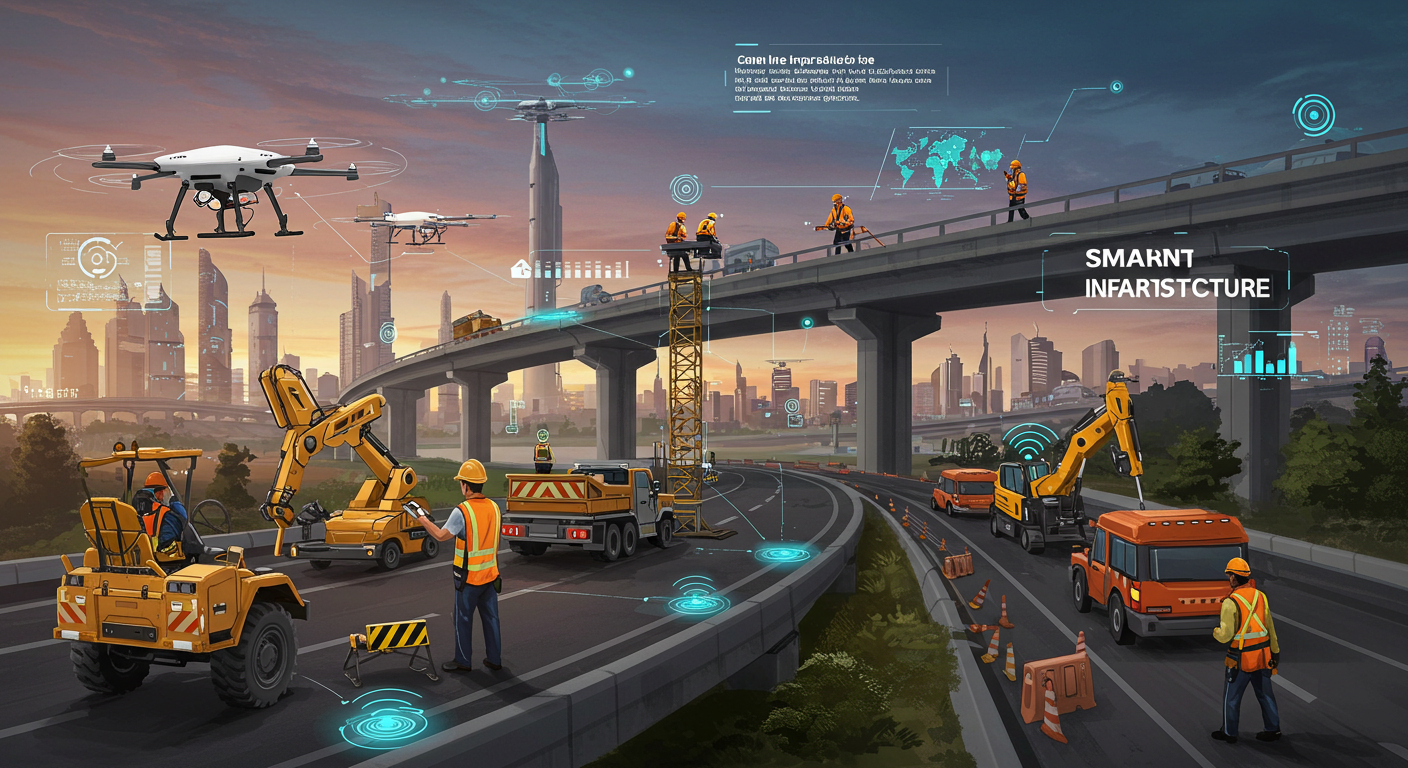Smart infrastructure is rapidly reshaping roadway construction, introducing advanced technologies that redefine how roads are built, maintained, and managed. With digital innovation influencing every aspect of the process, sector leaders like Cillessen Construction are implementing cutting-edge solutions to accelerate project timelines and optimize safety. The adoption of these smart systems marks a new era in transportation, where efficiency, sustainability, and real-time data are at the core of development strategies.
The effects reach far beyond quicker builds; smart infrastructure is facilitating continuous monitoring, predictive maintenance, and interconnected traffic networks that respond instantly to changing conditions. As cities and states strive for safer, longer-lasting roadways, the collaboration between traditional engineering and digital expertise paves the way for resilient, future-ready transportation corridors.
Automation and Robotics
Automation and robotics are at the forefront of modern construction sites, streamlining heavy labor and ensuring higher consistency in quality. Today’s roadway projects utilize robotic machines for earthmoving, grading, and paving, resulting in more predictable outcomes. Drones play a vital role in mapping and monitoring, reducing risks to workers and enabling the creation of detailed 3D models from overhead perspectives. Self-driving rollers and robotic flaggers further protect personnel and maintain construction speed, resulting in earlier project completion with fewer on-site hazards. This shift not only minimizes disruption but also supports accelerated public access to finished roadways.
Internet of Things (IoT) Sensors
IoT sensors are embedded across construction zones and finished infrastructure to provide continuous real-time monitoring. These sensors track crucial metrics, such as stress, vibration, temperature, and moisture, instantly alerting engineers to emerging issues. For instance, IoT-equipped bridges can detect abnormal stress levels before they escalate into structural failures, allowing for swift and cost-effective repairs. The adoption of IoT road sensors enables authorities to proactively address weaknesses, thereby extending the usable life of public assets.
Artificial Intelligence and Predictive Maintenance
Artificial Intelligence (AI) leverages aggregated sensor data to detect patterns and forecast infrastructure wear or potential failures. Predictive maintenance, enabled by these AI insights, prompts repairs just before problems occur, reducing operational costs and avoiding extensive damage. Cities across the Midwest, such as Indianapolis and Milwaukee, are pioneering predictive models for water and transportation systems, reporting significant savings and enhanced resilience. AI’s influence in road construction extends from machine guidance to optimization of materials and scheduling, fueling advances in resource allocation and cost management.
Digital Twins
Digital twins are sophisticated virtual replicas of roadways and their environments. Using these digital models, engineers can simulate and optimize everything from traffic flow to load-bearing capacities before breaking ground. This preemptive analysis reduces missteps and maximizes the value of investments, leading to fewer construction delays and more efficiently designed roads. By integrating real-time sensor data, digital twins evolve in tandem with the actual infrastructure, supporting ongoing management and adaptive improvements throughout a roadway’s lifecycle.
Smart Work Zones
Smart work zones leverage radar, cameras, and dynamic signs to increase safety and maintain traffic flow during construction. Systems like dynamic merge actively guide drivers depending on road congestion and speed, offering tailored instructions for smooth transitions. This approach has been demonstrated to reduce rear-end collisions and optimize the use of existing lanes, particularly during peak traffic periods. Automated messaging and variable speed limits further alert motorists to hazards, contributing to a record decline in work zone injuries for both crews and travelers.
Blockchain for Infrastructure Maintenance
Blockchain’s transparent, automated record-keeping is streamlining the complex web of contracts, payments, and compliance requirements in maintenance projects. Smart contracts execute terms automatically once conditions are met, from materials delivery to work validation. This technology not only prevents disputes and delays but also fosters trust between vendors, contractors, and public agencies. The end result is faster, more accountable repairs and greater clarity on long-term infrastructure performance.
Intelligent Transportation Systems
Intelligent Transportation Systems (ITS) are the backbone of smart mobility, integrating real-time analytics and automation into daily traffic management. Adaptive signals respond instantly to changing vehicle volumes, while connected vehicle technology enables cars and roadside systems to communicate seamlessly, improving route planning and reducing the likelihood of collisions. Notable global initiatives in Singapore and Copenhagen have leveraged ITS to cut urban congestion by up to 25% and lower accident rates by 40%. As ITS continues to evolve, it also brings benefits such as electronic tolling and automated incident response, setting new benchmarks for roadway efficiency and user satisfaction.
Empowering the Workforce
As construction becomes more technologically advanced, the workforce is experiencing a profound shift. Today’s projects require collaboration among civil engineers, software developers, data analysts, and field technicians. Upskilling in digital modeling tools, sensor diagnostics, and AI analysis is now standard practice, with companies investing heavily in training and up-to-date certifications. Education initiatives and platform-driven courses—often facilitated by leading industry software providers—are enabling professionals to leverage the latest advancements. The ongoing evolution of roles and responsibilities will continue to shape a more agile, innovative, and safety-conscious industry for years to come.
Conclusion
Smart infrastructure is reshaping roadway construction by merging advanced technology with traditional engineering practices. From data-driven design to sensor-equipped materials and intelligent traffic systems, these innovations not only improve efficiency and durability but also enhance safety and sustainability. As cities and communities continue to grow, integrating smart solutions into roadway projects ensures that transportation networks remain resilient, adaptive, and capable of meeting future demands. Ultimately, the transformation brought by smart infrastructure is setting a new standard for how we build and maintain the roads that connect us.

